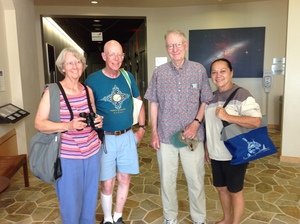'Imiloa Astronomy Center's grounds persons recently noticed a strange sight in the early mornings on the property, a group of people at dawn with nets, looking intently for something on the ground to catch. As it turns out, they are a team doing research on the Pacific Golden-Plover (pluvialis fulva), know in Hawai'i as the kolea, and they are looking for bird #10.
This moderately small, yellow-and buff mottled bird winters in Hawaii and breeds in western Alaska and as far as Siberia in the summertime.
Did you know that the kolea will return to the exact same wintering territory each year? Yeah, so the kolea you see each year in your yard and your area, is the same neighbor returning from a long, long journey! Roughly 2,500 miles and 50 plus hours of flight time are accomplished by these shorebirds on the non-stop journey. When they are wintering, they are eating terrestrial insects like cockroaches, moths, caterpillars, and earwigs while they await their return to Alaska to meet a new mate.
'Ai no ke kōlea a momona hoi'i Kahiki, as one Hawaiian proverb goes: The plover eats until fat, and then returns to the land from which it came.
Introducing Oscar W. (Wally) Johnson, adjunct professor in ecology at Montana State University-Bozeman. He has been studying the Pacific Golden-Plover over 30 years, ever since noticing them in the Marshall Islands while researching the kidney function of birds that live around salt water. Johnson and his team band the birds in Hawai'i and attach small geo-locators with the goal of learning where these birds nest in Alaska.
Wally and his team are the mysterious persons in the early morning trying to catch bird # 10, our own 'Imiloa kolea. Apparently, 2 years ago they caught 12 birds around the University of Hawai'i at Hilo Campus and # 10 was one that resides on the north end of our property otherwise known as the 'Ehukai (seascape) garden.
Asking about the kolea life in Alaska he states:
"Adult male plovers arrive in western Alaska and begin display flights to attract females. When the females pull in a couple of days later, they mate with the first male that impresses them with his lichen-lined nest, slow-beating wings and gaudy feathers. Then the female lays four eggs. The eggs hatch after about 26 days. Since the babies can find their own food within a day and fly when they're about 30 days old, the parents leave them in early August to return to Hawaii."
Adding, "Meanwhile, the young birds... are fattening up in preparation for their first migration which is without mom and dad. Their first big migration south is in September or early October, about one month after the adults leave. If they make it to land, they may find a cleared patch of land for their territory and may have to compete for it."
They are in good status as well. Wally states that since the kolea are ok with urbanization, fortunately they are able to adapt to a changing environment, usually one that leaves more open areas such as lawns, yards and open spaces.
Here at 'Imiloa we share the story of the Hawaiian navigator's, and the kolea like many other birds would indicate or show direction to land. As well, the kolea connects Hawaii to Kahiki, a distant and strange land.
"Kahaiki is a traditional place where gods, nobility, people and material goods were brought to Hawaii. Voyagers brought different religious rites and ways of governing from this land. Some animal were thought to come from Kahiki. Every winter certain birds like the kōlea migrate from Kahiki, then return there in the summer."
-- From the exhibit, "No Kahiki, He 'Āina Mamao"
Mahalo Wally Johnson for introducing the 'Imiloa 'ohana to bird #10, and to the connections we would not have realized with our resident kolea.
